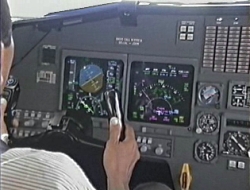

ENGLISH POSTUGUÊS
Source: American Physical Society
Date: September 27, 2007 Solving A Dragonfly Flight Mystery
Science Daily - Dragonflies adjust their wing motion while hovering to conserve energy, according to a Cornell University study of the insect's flight mechanics. The revelation contradicts previous speculation that the change in wing motion served to enhance vertical lift.
Dragonflies have two pairs of wings, which sometimes move up and down in harmony. At other times the front set of wings flap out of sync with the back set.
The Cornell physicists came to their conclusions after analyzing high speed images of dragonflies in action.
The physicists found that dragonflies maximized their lift, when accelerating or taking off from a perch, by flapping both sets of wings together. When they hover, however, the rear wings flap at the same rate as the front, but with a different phase (imagine two people clapping at the same speed, but with one person's clap delayed relative to the other).
The physicists' analysis of the out-of-sync motion showed that while it didn't help with lift, it minimized the amount of power they had to expend to stay airborne, allowing them to conserve energy while hovering in place.
The research will be detailed in a forthcoming issue of Physical Review Letters. The authors are Z. Jane Wang and David Russell.
Data: 27 SET 2007
Solucionando o Mistério do Vôo da Libélula
Ciência Diária – Libélulas ajustam o movimento de suas asas enquanto flutua para conservar energia, de acordo com um estudo da mecânica de vôo do inseto na Universidade Cornell. A reveleção contradiz especulação anterior de que a mudança no movimento da asa servia para melhorar a sustentação vertical.
Libélulas têm dois pares de asas, as quais algumas vezes as move para cima e para baixo em harmonia. Em outras vezes o grupo de asas frontais abaixam fora de sincronismo com o grupo traseiro.
Os físicos de Cornel chegaram à suas conclusões após analisar imagens em alta velocidade de libélulas em ação.
Os físicos descobriram que libélulas maximizavam suas sustentações, quando acelerando ou decolando de um poleiro, ao flapear ambos conjuntos de asas juntos. Quando elas flutuam, contudo, as asas traseiras movem na mesma razão que as frontais, mas com uma fase diferente (imagine duas pessoas batendo palmas na mesma velocidade, mas com o aplauso de uma pessoa atrasado em relação a outra).
A análise dos físicos em relação a falta do movimento de sincronia mostrou que enquanto ela [sincronia] não ajudou com sustentação, ela minimizou a quantidade de potência que elas tinham para gastar para ficarem no ar, permitindo-as conservarem energia enquanto flutuando no local.
A pesquisa será detalhada numa edição futura de Physical Review Çetters. Os autores são Z. Jane Wang e David Russel.
Tradução por George Rocha
Em 15 OUT 2007
Collection of the Illinois State Museum Photographed by Dr. Everett Cashatt
Simulation of the aerodynamics of a dragonfly's flight
Computer simulation of a hovering dragonfly's wing reveals the vortices of swirling air that keep the insect aloft. The figure-8 motion of the wing (shown in white, with the leading edge toward the Y axis) has produced clockwise (blue and green) as well as counterclockwise (red) vortices. Z. Jane Wang/Cornell University.
This image is copyright © Cornell UniversityAll rights reserved Permission is hereby granted to news media to reproduce this image when reporting Cornell-related news, provided that Cornell University and the photographer or artist are credited. Permission is also extended to private individuals to make copies for personal use not involving physical or electronic distribution. For any other use, for profit or otherwise, please contact Cornell University News Service.
mailto:cunews@cornell.edu
mailto:cunews@cornell.edu





Nenhum comentário:
Postar um comentário